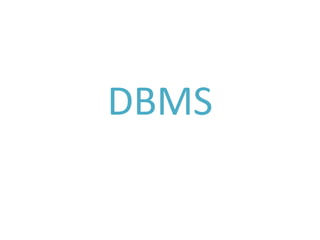
Dbms
- 1. DBMS
- 2. Introduction 1. It is a software package with computer programs that control the creation, maintenance, and the use of a database. 2. Collection of interrelated data. 3. Set of programs to access data.
- 3. History • In 1977, computer programmers Larry Ellison and Robert Miner co-founded Oracle Systems Corp. • In 1983, Oracle developed the first portable RDBMS, which allowed firms to run their DBMS on various machines including mainframes, workstations, and personal computers. • Soon thereafter, the firm also launched a distributed DBMS, based on SQL-Star software.
- 4. Components of DBMS • Data definition subsystem • Data manipulation subsystem • Data administration subsystem • DBA (Database Administrator) • Database user • Hardware
- 5. Features of DBMS • Accept data input & store • Multi-user access • Security • Query languages (searching, sorting)
- 6. Data Models 1. Data model: A way to design a dbase or describe a database 2. Data modeling: Process of creating a data model 3. Data Models the hierarchical model the network model the relational model the multidimensional model, and the object model
- 7. E-R Model
- 8. Hierarchical Model • Data or records are organized in a hierarchy manner. • Used to present the hierarchy of an organization.
- 9. Network Model • It is an extension of hierarchal model • In this model, data elements of a database are organized to have parent -child relationship
- 10. Relational Model • A database in which relations between information items are explicitly specified as accessible attributes. • Data are stored or organized in tables.
- 11. Multidimensional Model • It is a variation of the relational model that uses multidimensional structures to organize data and express the relationships between data.
- 12. Object Model • It is a database management system in which information is represented in the form of objects as used in Object-Oriented Programming.
- 13. Applications Of DBMS • Banking: For customer information, accounts loans and banking transactions. • Airlines: For reservations and schedule information. • Universities: For student information, course registrations and grades. • Credit card transactions: For purchases on credit cards and generation of monthly statements. • Telecommunications: For keeping records of calls made, generating monthly bills,etc..
- 14. Contd.. • Finance: For storing information about holdings, sales and purchase of financial instruments such as stocks and bonds. • Sales: For customer, product and purchase information. • Manufacturing: For management of supply chain and for tracking production of items in factories. • Human Resources: For information about employees, salaries, payroll taxes. • Web based services: For taking web users feedback, responses, resource sharing etc.
- 15. Advantages Of DBMS • It represents complex relationships among different data items. • Keeps a tight control on data redundancy. • Maintains data dictionary for the storage of information pertaining to data fields and data manipulation. • Ensures that data can be shared across all applications. • Has an automatic intelligent backup and recovery procedure of data.
- 16. Disadvantages Of DBMS • Database systems are complex, difficult, and time-consuming to design. • Substantial hardware and software start-up costs. • Damage to database affects virtually all applications programs. • Extensive conversion costs in moving form a file-based system to a database system. • Initial training required for all programmers and users.